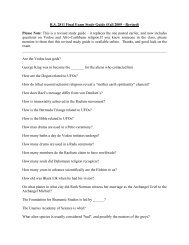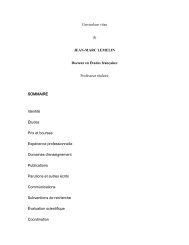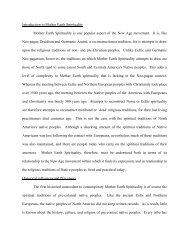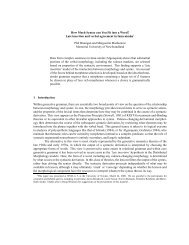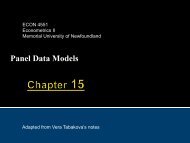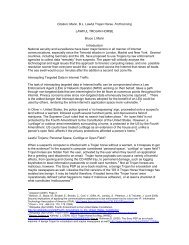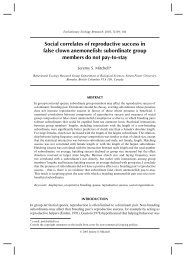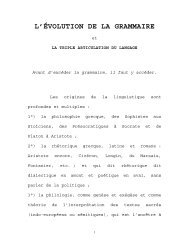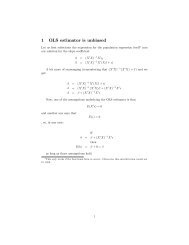Answers to the Exercises -- Introduction
Answers to the Exercises -- Introduction
Answers to the Exercises -- Introduction
Create successful ePaper yourself
Turn your PDF publications into a flip-book with our unique Google optimized e-Paper software.
<strong>Introduction</strong> -- <strong>Answers</strong> <strong>to</strong> <strong>the</strong> <strong>Exercises</strong><br />
<strong>Answers</strong> <strong>to</strong> <strong>the</strong> <strong>Exercises</strong> -- <strong>Introduction</strong><br />
SECTION 2<br />
1. a. INVALID Any possible situation in which Lee was a president but nei<strong>the</strong>r of <strong>the</strong> o<strong>the</strong>rs was.<br />
b. INVALID Any possible situation in which Polk was a president but nei<strong>the</strong>r of <strong>the</strong> o<strong>the</strong>rs<br />
was.<br />
c. VALID<br />
d. INVALID Any possible situation in which Whitney was a president and nei<strong>the</strong>r of <strong>the</strong> o<strong>the</strong>rs<br />
was.<br />
2. a. True. (Such an argument will always have at least one false premise.)<br />
b. False. Some do; some don't.<br />
c. True.<br />
d. False. Sometimes adding a premise converts an invalid argument in<strong>to</strong> a valid one, and<br />
sometimes it does not. It depends on what you add.<br />
e. True. There can't be a possible situation in which it has all true premises and a false conclusion<br />
because <strong>the</strong>re can't be a possible situation in which it has all true premises.<br />
f. True. There can't be a possible situation in which it has all true premises and a false conclusion<br />
because <strong>the</strong>re can't be a possible situation in which it has a false conclusion.<br />
g. False. It might be valid, or it might be invalid.<br />
3. a. False. Valid arguments with false premises aren't sound.<br />
b. True. An invalid argument isn't sound because it isn't even valid.<br />
c. True. The premises are all true, and it's valid, so its conclusion must be true <strong>to</strong>o.<br />
d. False. If you add a true premise it will remain sound, but if you add a false premise it will become<br />
unsound.<br />
e. False. A valid argument is unsound if it has a false premise.<br />
f. False. If <strong>the</strong> conclusion is necessarily true <strong>the</strong> argument will be valid, but it still might have a false<br />
premise, and thus be unsound.<br />
4. It has <strong>to</strong> be valid. For suppose it were not. Then <strong>the</strong>re would be a possible situation in which A is true<br />
and C is false. Since <strong>the</strong> first argument is valid, B is true in this situation; but <strong>the</strong>n since <strong>the</strong> second<br />
argument is valid, C is also true in that situation, contradicting our supposition that <strong>the</strong>re is a situation in<br />
which A is true and C is false.<br />
5. It has <strong>to</strong> be sound. It has <strong>to</strong> be valid for <strong>the</strong> same reason as in <strong>the</strong> previous example. And since <strong>the</strong><br />
first argument is sound, A is true. So its premise is true.<br />
6. We know that at least one of <strong>the</strong>m is invalid, but we don't know which. If <strong>the</strong>y were both valid, <strong>the</strong> first<br />
argument would have <strong>to</strong> be valid, as in exercise 4. So <strong>the</strong>y aren't both valid. But <strong>the</strong>re are cases in<br />
which <strong>the</strong> first is valid and <strong>the</strong> second invalid, and cases in which <strong>the</strong> first is invalid and <strong>the</strong> second valid,<br />
and cases in which <strong>the</strong>y are both invalid.<br />
First valid and second invalid:<br />
A<br />
B<br />
C<br />
Polk was a president<br />
Polk or Lee was a president<br />
Lee was a president<br />
<strong>Introduction</strong> -- <strong>Answers</strong> <strong>to</strong> <strong>the</strong> <strong>Exercises</strong> -- 1
<strong>Introduction</strong> -- <strong>Answers</strong> <strong>to</strong> <strong>the</strong> <strong>Exercises</strong><br />
First invalid and second valid:<br />
A Polk was a president<br />
B Polk and Lee were presidents<br />
C Lee was a president<br />
Both invalid:<br />
A Polk was a president<br />
B Nixon was a president<br />
C Lee was a president<br />
7. a. Polk was a president.<br />
∴ Polk wasn't a president.<br />
[Naturally, <strong>the</strong> argument is invalid.]<br />
b. Polk was a president.<br />
∴ Ei<strong>the</strong>r Whitney was a president or he wasn't.<br />
This argument is valid; it cannot have all true premises and a false conclusion because it cannot<br />
have a false conclusion.<br />
SECTION 5<br />
1. a. Ei<strong>the</strong>r McGovern or Nixon was president.<br />
Ei<strong>the</strong>r Nixon or Goldwater was president<br />
∴ Ei<strong>the</strong>r McGovern or Goldwater was president.<br />
b. The original argument will do; it already has all true premises and a false conclusion.<br />
c. VALID.<br />
d. Ei<strong>the</strong>r Whitney or Polk was a president.<br />
Lee was not a president.<br />
∴ Lee wasn't a president and Whitney was.<br />
2. a. False.<br />
b. False. This does not show that no argument with that form has true premises and a false<br />
conclusion.<br />
c. False. You might not have looked hard enough.<br />
3. a. VALID<br />
b. INVALID If Polk and Lee were both presidents, Polk was a president.<br />
Polk was a president.<br />
∴ Polk and Lee were both presidents.<br />
c. VALID<br />
d. INVALID Lee or Polk was a president.<br />
Polk was a president.<br />
∴ Lee was a president.<br />
e. VALID<br />
<strong>Introduction</strong> -- <strong>Answers</strong> <strong>to</strong> <strong>the</strong> <strong>Exercises</strong> -- 2
<strong>Introduction</strong> -- <strong>Answers</strong> <strong>to</strong> <strong>the</strong> <strong>Exercises</strong><br />
f. VALID<br />
g. VALID (This depends interpreting `or' inclusively; this is discussed in chapter 2 below.)<br />
4. a. Yes. It shows <strong>the</strong> original argument invalid, and an invalid argument is not sound.<br />
b. No. The original argument could still be invalid, or have a false premise, or both.<br />
Example:<br />
Original argument:<br />
Lee was a president<br />
∴ Whitney was a president<br />
c. It shows nei<strong>the</strong>r.<br />
Examples:<br />
Original unsound argument:<br />
Lee wasn't a president<br />
∴ Whitney wasn't a president<br />
Original sound argument:<br />
Lee wasn't a president<br />
∴ Lee wasn't a president<br />
"Found" argument:<br />
Nixon was a president.<br />
∴ Kennedy was a president.<br />
"Found" argument:<br />
Nixon wasn't a president.<br />
∴ Kennedy wasn't a president.<br />
"Found" argument:<br />
Nixon wasn't a president.<br />
∴ Nixon wasn't a president.<br />
5. a. Some arguments with this form are sound: <strong>the</strong> ones with true premises.<br />
But not all; some of <strong>the</strong>m have false premises.<br />
b. None are sound, since none are valid.<br />
c. Some arguments with this form are sound: <strong>the</strong> ones with true premises.<br />
But not all; some of <strong>the</strong>m have false premises.<br />
d. None are sound, since none are valid.<br />
e. None are sound, since none has a true premise.<br />
f. Some arguments with this form are sound: <strong>the</strong> ones with true premises.<br />
But not all; some of <strong>the</strong>m have false premises.<br />
g. Some arguments with this form are sound: <strong>the</strong> ones with true premises.<br />
But not all; some of <strong>the</strong>m have false premises.<br />
6. Many logicians think that <strong>the</strong>re are arguments that are valid, but not formally valid. An example<br />
is:<br />
Herman is a bachelor<br />
∴ Herman is unmarried<br />
The validity of this argument comes from <strong>the</strong> meaning of <strong>the</strong> word 'bachelor', and not from <strong>the</strong><br />
form of <strong>the</strong> sentences in <strong>the</strong> argument.<br />
As we have defined 'formally valid', any argument that is formally valid is au<strong>to</strong>matically valid.<br />
<strong>Introduction</strong> -- <strong>Answers</strong> <strong>to</strong> <strong>the</strong> <strong>Exercises</strong> -- 3



